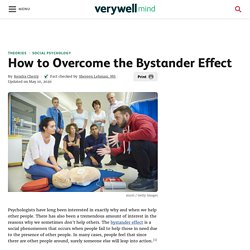

Officially, the definition of the bystander effect is the inhibiting influence of the presence of others on a person’s willingness to help someone in need. In other words, it is when a person is being influenced by a group of people not to act in an emergency.
Bystander effect – APA Dictionary of Psychology.
Bystander Effect. The Bystander Effect. If You’re in Danger, Will Bystanders Help? Almost every psychology student knows about Kitty Genovese, the 28-year-old Queens woman who was stabbed to death in 1964.

At the time, the New York Times reported that no one had lifted a finger to rescue her. Though that story was later debunked—some people did call the police or shout down the assailant—Genovese’s death provoked a flurry of research on what’s now called the bystander effect. According to decades of experiments, the more people who are observing someone in trouble, the less likely each person is to help. Today, however, new studies are calling the bystander effect into question—and sketching a somewhat sunnier picture of human nature. Most recently, researchers from the U.K.’s Lancaster University, the University of Copenhagen, and elsewhere captured a series of real-life conflicts on surveillance cameras and found that at least one person in the vicinity came forward to help about 90 percent of the time. Bystander behavior, revisited Overblown coverage ―Dr. ―Dr. ―Dr. The legend of Kitty Genovese and those who ignored her screams.
When I was growing up in New York City, everyone knew about Kitty Genovese.

We all knew the story of the 28-year-old bar manager who had been robbed, raped and stabbed to death outside her apartment building in Queens in 1964 while 38 people watched or listened to her screams outside their apartments but did nothing to stop the attack. It was more than just another tabloid murder; it was a morality tale — exhibit A for the argument that cities were alienating and dehumanizing, that there was no such thing as neighborhood or community, that people were cold, cruel, selfish, indifferent. Even today, Kitty Genovese’s name is still invoked not just in New York but around the world when people fail to come to each other’s aid in times of violence and trouble.
Thirty-eight witnesses, the New York Times said, and no one did anything over the 35 minutes the attack was taking place. Not one called the police while it was underway, even though Genovese was screaming, “Please help me. 10 Notorious Cases of the Bystander Effect. The bystander effect is the somewhat controversial name given to a social psychological phenomenon in cases where individuals do not offer help in an emergency situation when other people are present. The probability of help has in the past been thought to be inversely proportional to the number of bystanders.
From Empathy to Apathy: The Bystander Effect Revisited - Ruud Hortensius, Beatrice de Gelder, 2018. When people are asked whether they would spontaneously assist a person in an emergency situation, almost everyone will reply positively.

Although we all imagine ourselves heroes, the fact is that many people refrain from helping in real life, especially when we are aware that other people are present at the scene. In the late 1960s, John M. Darley and Bibb Latané (1968) initiated an extensive research program on this so-called “bystander effect.” In their seminal article, they found that any person who was the sole bystander helped, but only 62% of the participants intervened when they were part of a larger group of five bystanders. Following these first findings, many researchers consistently observed a reduction in helping behavior in the presence of others (Fischer et al., 2011; Latané & Nida, 1981). Reducing the Bystander Effect. How to Overcome the Bystander Effect.
Psychologists have long been interested in exactly why and when we help other people.

There has also been a tremendous amount of interest in the reasons why we sometimes don't help others. The bystander effect is a social phenomenon that occurs when people fail to help those in need due to the presence of other people. In many cases, people feel that since there are other people around, surely someone else will leap into action.1 While the bystander effect can have a negative impact on prosocial behavior, altruism and heroism, researchers have identified a number of different factors that can help people overcome this tendency and increase the likelihood that they will engage in helping behaviors.2 Some of these include: Witnessing Helping Behavior Sometimes just seeing other people doing something kind or helpful makes us more willing to help others.
Imagine that you are walking into a large department store. Being Observant Being Skilled and Knowledgeable Guilt Feeling Good. Overcoming the Bystander Effect. How tech can combat the bystander effect. The responsibility to help during an emergency falls on anyone present and capable of lending a hand.

While there may be occasional good Samaritans who are able to aid, more often than not, the main responsibility falls on emergency respondents to step in. Understandably, the shock of witnessing a mugging, hijacking, terrorist attack or even a car accident can leave a bystander paralysed with shock and uncertain about what to do, or even fearful of getting involved altogether. A harrowing, often-cited case in point is the 1964 murder of Kitty Genovese – a New York woman was stabbed to death outside her apartment while dozens of witnesses reportedly heard her crying for help, and not a single one stepped into help or even called the police. While recent investigations have called into question just how many witnesses there were at the scene, the fact is that no one offered to help or even call for qualified aid.